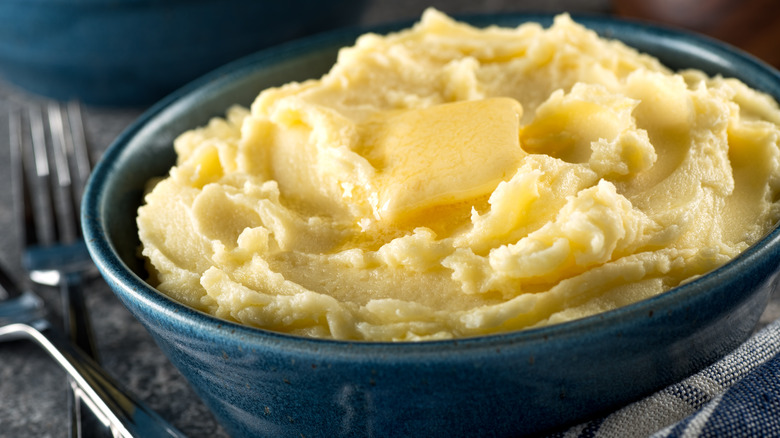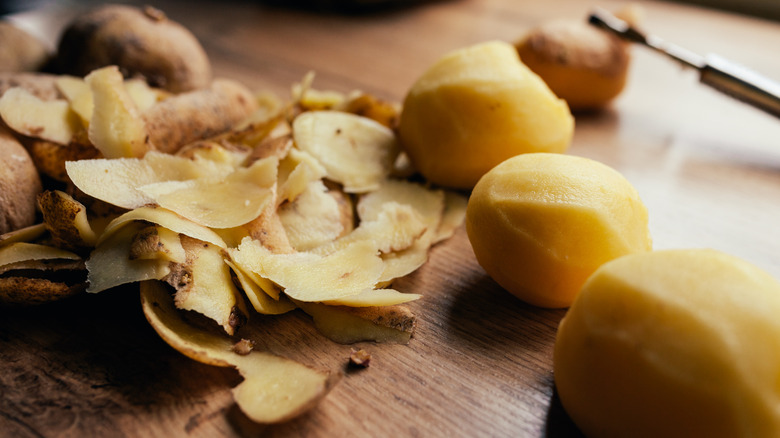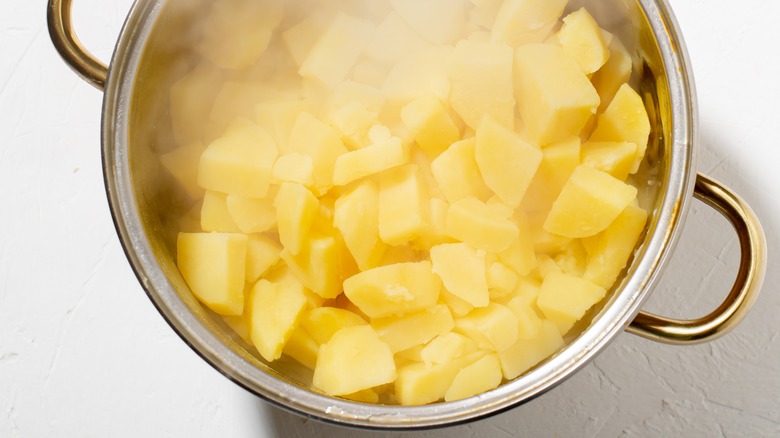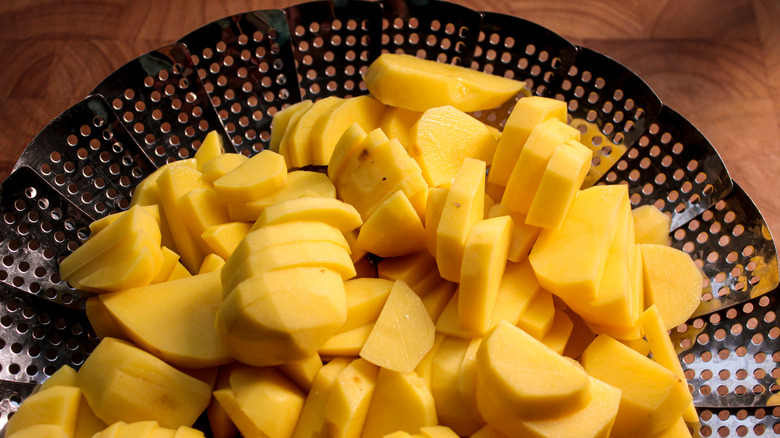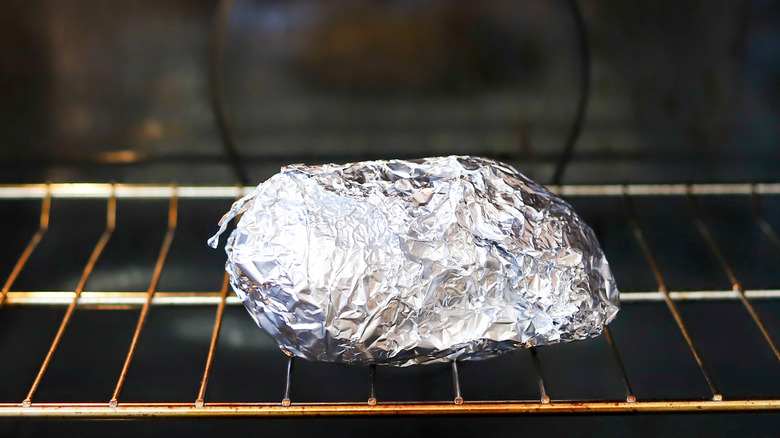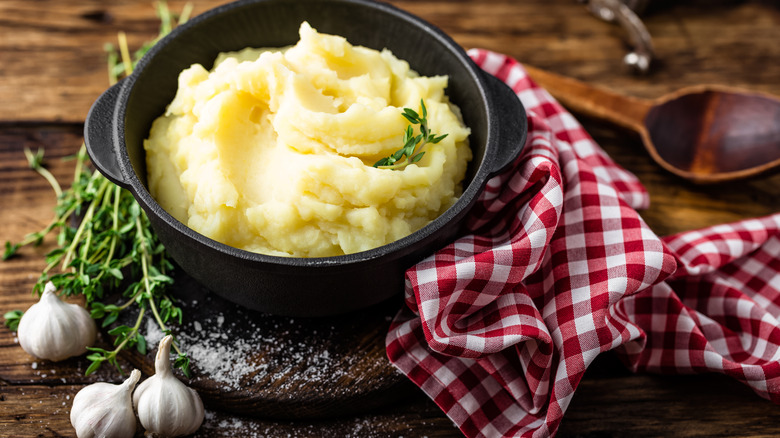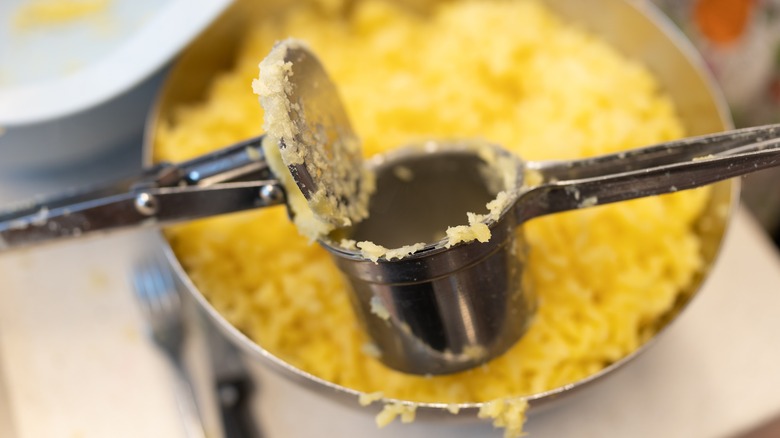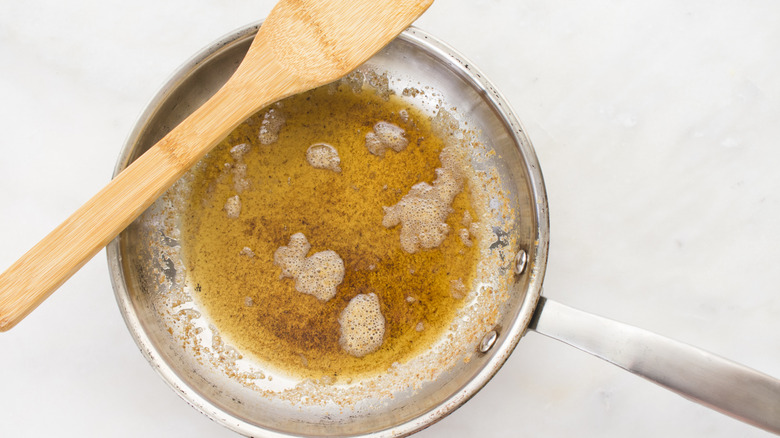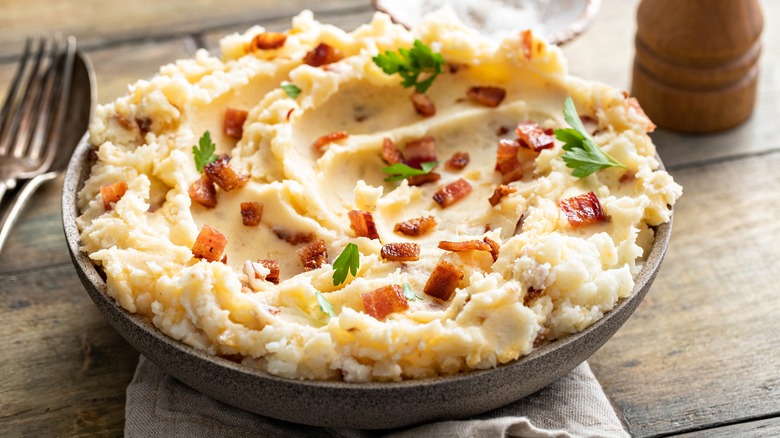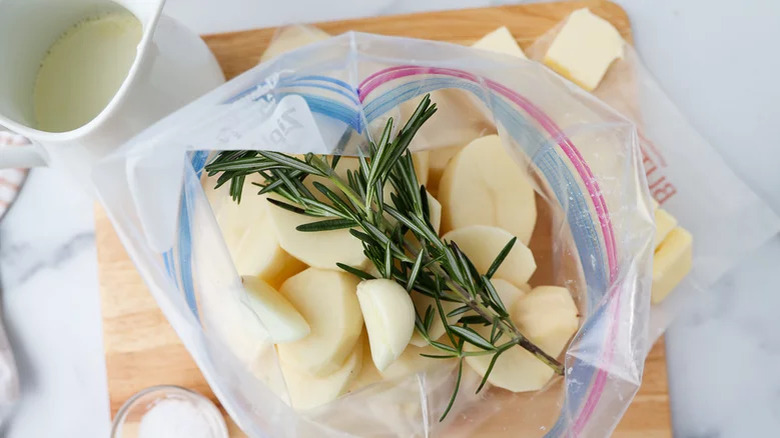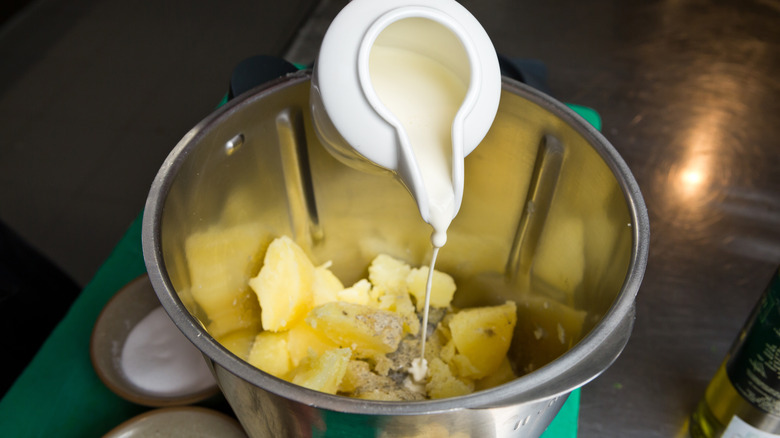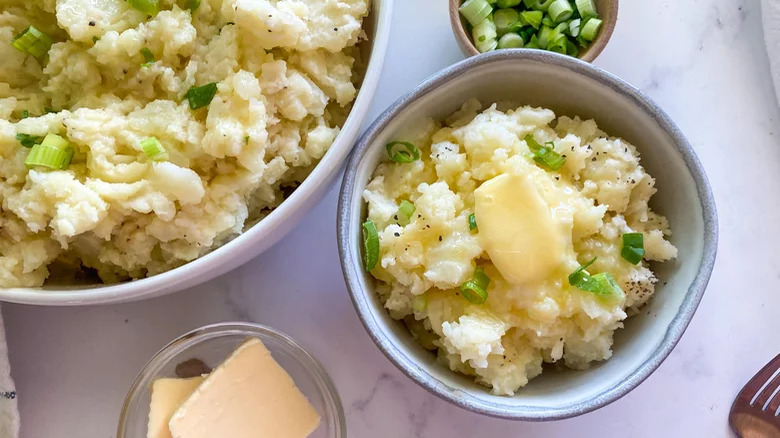Why Mashed Potatoes Always Taste Better At A Restaurant
If you love old-fashioned meat-and-potatoes meals, then you no doubt adore mashed potatoes. Who doesn't? These creamy, buttery carbs are not only delicious, but they pair well with just about anything. But why is it that, no matter how you make them, mashed potatoes always taste better at a restaurant, or seem to anyway? Perhaps one of the reasons is that you aren't at home mashing hot potatoes yourself. Even staples like mash are often more enjoyable when they are being cooked for you instead of by. But this isn't the full story, just part of it.
Restaurant mash is better because of how the potatoes are cooked and mashed. What ingredients are added, when, and how are also important. At a restaurant, you can enjoy luxurious-tasting potatoes that feel like silk. Restaurant chefs use tried and tested mashed potato hacks to get this sublime side just right. What you are going to love about these tips is that they are all fairly easy to replicate at home, meaning that for the most part, you don't need any special equipment — just a little culinary know-how. Let's walk behind the scenes into the world of restaurant kitchens and discover ideas that you can try at home. It starts with choosing the right potatoes, so get your masher ready.
Restaurants make mash with the best potatoes
You don't need to be a culinary genius to know that the main ingredient in mash is potatoes. And one of the things that make mashed potatoes taste better at a restaurant is that experienced chefs know which varieties are the best to use. Certain potatoes are known for being delicious when cooked and mashed. Along with the variety of potatoes you use, quality is vital. At home, you may mash a few potatoes that look like they need to be cooked before they go bad. However, many restaurants pride themselves on serving mash that's as good as any other dish. Spongy potatoes that are sprouting or look mangled and bruised are a no-no.
In the U.S., russet potatoes are a great choice. The starchiness in this variety creates a fluffy texture instead of a dish that's stodgy, dense, or watery. There's no reason to use one type of potato though. A restaurant might be cooking up all manner of potato dishes from fries to hash browns and have a lot of potato varieties on hand. Yukon Gold potatoes make great mash when combined with russets as they don't absorb much water during cooking, which means they don't turn into a gooey glop when mashed. Yukon Golds also have a robust flavor with buttery notes. The combination of creamy Yukon Golds and light russets is so good. For a skin-on mash with a subtly sweet flavor, fingerling potatoes are a great choice.
The potatoes are prepped with care
Professional restaurant chefs always have a good set of sharp knives and a quality peeler. The proper tools make light work of prepping potatoes for mash and this can make all the difference to the final result. Let's face it, good chefs are often perfectionists so when they peel a potato they'll often do so in seconds. There won't be a speck of dirt or peel left. Any eyes or bruises that are visible are gouged out or cut off. Even if the discolored parts of a potato can technically be eaten, restaurant-style mash always looks pure because these bits are trimmed off. The prepped potatoes are then added to cold water and rinsed to get rid of any remaining impurities and to stop them from turning brown. That way there aren't any imperfections in the mash.
What's super important as well is not cutting the potato pieces too small. It's true that small pieces will have more surface area and cook in less time. However, if they're too small they'll absorb excess water and become soggy. Halving the potatoes before cooking results in a mash that isn't too watery, allowing it to absorb any creamy, buttery ingredients that are added. Any chef worth their salt knows that the potatoes need to be added to salted cold water that is then brought to a boil. Doing this instead of adding them to already-boiling water ensures they don't fall apart during cooking.
Potatoes may be steamed — not boiled
Mashed potatoes aren't exactly a complex dish to make — or so it seems — so it's not obvious why mashed potatoes always taste better at a restaurant. Those pro chefs must be pulling off some culinary wizardry to turn mashed potatoes from basic to sensational. When you make this side, do you start by boiling peeled potatoes in salted water before draining and mashing? Sounds reasonable, right? Surely there's no other way. But you're missing a trick, as some restaurants may steam their potatoes rather than boil them. This is actually a great hack to try as it hardly takes any more effort than traditional boiling. As long as you've got a steamer basket, you can just add this to a pan of boiling water.
Steaming stops the potatoes from soaking up too much water which can lead to mash that's a sloppy mess. In a busy kitchen with pots and pans bubbling and boiling away, chefs need to multitask to the max. By throwing potatoes in a steamer there's more leeway with cooking times and if they are on too long it's not going to ruin them. Home cooks sometimes let a pan of potatoes boil for too long and their mash inevitably turns into mush. Potatoes should be cut into similar-sized pieces before being added to the steamer to ensure even cooking.
Some chefs roast potatoes
Do you know a way of making mash without boiling or steaming potatoes? It's not a trick question, but a good-to-know technique that some chefs prefer to use when making a marvelous mash for restaurant diners. However you like your mash, few enjoy it when it's too watery, and roasting a potato in its skin, as you would a baked potato, keeps it nice and dry. The skins aren't used when mashing though, just the fluffy potato inside. Of course, if you prefer your mash rustic style, you might find it better to boil the potatoes with the skins on instead. Baked potato skins could be too leathery to include in the mash.
Try it yourself by pricking the potatoes before popping them in a hot oven. You can sit them on some salt on a tray, which also helps reduce the moisture in the vegetable. You can also simply pierce the raw potatoes, cover the entire tray with aluminum foil, and bake them in an oven at 400 degrees Fahrenheit for an hour. Once they have cooled down enough to touch, remove the soft interiors and fluff up with some butter and cream. You can also add in some milk. If you want to keep your oven free, you can cook air fryer baked potatoes and use those to make mash.
Garlic and herbs are added to boost flavor
Instead of boiling a few potatoes and mashing them plain, a lot of restaurant chefs like to apply a little more finesse. Garlic and herbs infused in butter and cream add a flavor boost without overpowering. TV culinary veteran Martha Stewart adds garlic cloves and fresh thyme into cheesecloth in a strainer over a saucepan. She pours hot brown butter over this so that it can grab some of the flavors. After removing the strainer, the infused mix is then added to pureed potatoes. How superb does this sound?
Another infusion method is to add garlic cloves to the water the potatoes are boiling in. For an herby hit, add fresh rosemary to milk and butter. Heat this in the pan and remove the stalks before pouring the mixture into the cooked potatoes. For a simple garlic mashed potatoes recipe, mince garlic and add it to milk and butter in a pan. Heat and combine with boiled potatoes before mashing. This way, you'll get a garlicky mash without big pieces of garlic. You can also grate garlic into a mixture of butter and half-and-half before heating. Hot milk can be added directly to the potatoes with sour cream and butter. However, if you're enhancing your dairy with garlic and herbs, add them to melted butter first so the flavor can extract before it goes into the mash.
The potatoes are mashed with different equipment
How do you mash your potatoes? If you're human, you've probably reached for a fork when you can't find the masher. Restaurant chefs should know where all their kitchen equipment is. However, they might not even use a traditional masher. It turns out that there's more than one way to mash potatoes, and each results in a different texture. A ricer with fine holes breaks up the pieces of potato to create a consistency that's beautifully smooth. A food mill works in a similar way.
Perfectionists, or chefs working at fancy French restaurants, may use a tamis instead of (or in addition to) the ricer. This drum sieve does slow down the mashing process but if the aim is to make pureed, perfectly smooth mashed potatoes, then it's the way to go. Pressing hot mashed potatoes through an everyday fine mesh sieve is another option. The rounded surface allows you to you press down on the potatoes with the back of a large spoon. Some people whizz up mash using a hand mixer in order to achieve a restaurant-style result. Blenders or food processors might be tempting choices because they easily puree foods, but they are too violent for mashed potatoes and will leave you with a gluey end product.
Adding brown butter can provide extra flavor
It won't come as a huge surprise to you that restaurant chefs increase the quantities of butter when they make mash. Where do you think that sublime buttery taste comes from? It also creates that classic restaurant-style mash with a luxurious velvety texture. A little trick that elevates that contributes depth of flavor is to add brown butter into the mix. Martha Stewart likes to add brown butter and cream to her super-soft mash to elevate the flavor, which is perfect for French-style potato puree.
Restaurant chefs are used to watching more than one pan at a time. However, when making brown butter you do need to give it your full attention. That rich color and taste can turn bitter and burnt if you don't take it off the heat soon enough.
For three pounds of potatoes steamed until they are fork tender, she adds a stick and a half of butter. Instead of tossing the butter straight into the mash, she melts it in a saucepan. After melting, it turns brown and then can be added to the cream before whisking into the mashed potatoes. The brown butter enhances the taste of the dish with a wonderfully warming nutty flavor.
Delicious ingredients are added to the mix
Restaurants are great at giving mashed potatoes a culinary upgrade with tasty additions. Mash doesn't have to be an afterthought and can truly shine as a spectacular side or sophisticated entrée. Plenty of restaurants serve loaded mashed potatoes. A classic way to load up mashed potatoes is to add cheese, bacon, and sour cream. A more luxurious version includes Fontina cheese, shaved truffle, and chives. Our Instant Pot loaded mashed potatoes are a great recipe to try at home When the potatoes are cooked, half-mash them before adding any other ingredients. For this recipe, throw in some cooked bacon, cheddar cheese, sour cream, and green onions. Use a wooden spoon to combine thoroughly so that you get all the flavors in one delicious bite.
Blue cheese is one ingredient that is definitely going to tickle your taste buds and give mashed potatoes a creamy tang. Onion peps up mashed potatoes and chili flakes can cut the blandness with a little heat. Dill or other fresh herbs, both woody and soft, lend a distinctive taste and freshness, and they all go incredibly well with garlic. What's great is there aren't any rules, so restaurants can really go to town with their own unique creations. British T.V. chef Gordon Ramsay inspires with some ingredient suggestions such as adding English, wholegrain, and Dijon mustards. Another idea is to add white truffle oil with a porcini and truffle paste for a blast of umami.
They may use a sous vide machine
Mashed potatoes always taste better at a restaurant in part because you don't have to do any cooking (or clean up after). It's so great to cook amazing recipes at home but sometimes you can't beat someone else doing it for you. Restaurants sometimes have labor-saving devices that aren't common in home kitchens, and one they might use is a sous vide machine. If you want to make mash in advance and keep it warm and delicious until it's time to serve, you might want to try the sous vide method.
To do this, put a vacuum-sealed bag of pre-made mashed potatoes into the sous vide machine so that the water completely covers it. At 150 degrees Fahrenheit, it stays perfect and is ready to serve for another 24 hours. If you've got a machine at home, you could try actually making the mash from scratch by following our best sous vide mashed potatoes recipe. You need a large pot filled with water and a water circulator set to 194 degrees Fahrenheit. Add chopped, peeled potatoes to a freezer bag with smashed garlic cloves, fresh rosemary, cream, salt, and butter. When it's time to mash your tender potatoes, mix in some potato water to help get the right consistency.
Heated cream is whipped in just before serving
Do you think you're being fancy when you splash some cream into your mashed potato at home? It certainly adds a luxurious essence as well as a rich taste. You get some culinary points for that. What is it about mashed potatoes though, that taste so much better at a restaurant? The trick is to heat the cream before adding it. Heat cream in a pan, then throw in your already-mashed potatoes and mix. This method is used by restaurants to reheat pre-prepared mash. You can also add milk to the cream if you like. Heating up the cream ensures that it won't cool down your potatoes too much — no one likes a tepid mash.
For a more pureed potato consistency, hot cream needs to be gently folded in with a spatula. The butter and cream are mixed together, and you can also add chicken stock. In the U.S., mashed potatoes aren't usually served as smooth as this. However, you might find they have this consistency when served at an upmarket eatery or a French-style bistro. To make this type of mashed potato at home, you can add the cream and butter to the same pan as the mashed potato. Be sure to bring the heavy cream to a simmer before mixing it together with the potatoes. The amount you use really depends on how rich and decadent you want the potatoes to be
The garnish looks and tastes good
When you're whipping up a weekday dinner, such as a 30-minute chicken pot pie, you might make your own mashed potatoes too. However, chances are that if you're tired, you don't want to start messing around with garnishes to make your mash look pretty. You want some home-cooked comfort food to chow down on, and that's it. You could be missing out on a flavor by eschewing garnishes, however. One of the reasons mashed potatoes always taste better at a restaurant is because the garnish looks and tastes good too.
Simple garnishes often sprinkled on top include green onions and chopped chives. They add a peppery contrast with a bright green color and herby taste to freshen up the mash. You might enjoy cracking some black pepper on top, but white pepper is even better because you don't get any black dots and it has a milder flavor. Fresh parsley works wonderfully scattered on top and you can't go wrong with a pat of butter. No matter how much is in the mash already, the sight of extra butter melting on top of mashed potato peaks is mouthwatering. Some restaurants add sauce for a final flavor boost. For example, KFC serves its popular mashed potatoes with thick gravy. If you love that way of serving mashed potatoes, you can make our copycat KFC gravy recipe with chicken and beef bouillon along with black pepper.
